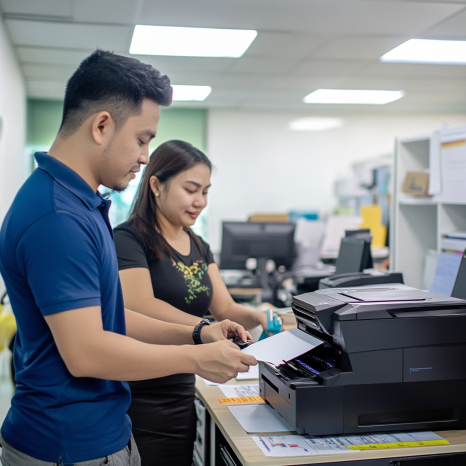
Training on Eco-friendly Printing
Introduction: Why Training on Eco-Friendly Printing Matters
In today’s environmentally conscious world, every business has a responsibility to adopt sustainable practices. One of the simplest yet most overlooked areas for improvement is printing. While digital transformation has reduced paper usage, printing still plays a vital role in many offices. The solution? Equip your team with proper training on eco-friendly printing.
With the right knowledge and habits, businesses can significantly reduce waste, save on operational costs, and meet green compliance standards. This blog explores the importance of eco-printing training, what it involves, and how companies can implement it effectively.
Understanding Eco-Friendly Printing
Eco-friendly printing refers to practices, equipment, and materials that reduce environmental impact. It goes beyond simply using recycled paper or energy-efficient printers—it’s about rethinking the entire printing process.
Key aspects include:
Using double-sided printing (duplexing)
Avoiding unnecessary print jobs
Choosing eco-conscious printer settings
Using refillable or remanufactured ink cartridges
Opting for certified energy-efficient printers
However, even the best technology can’t fulfill its purpose if people don’t know how to use it. That’s where training on eco-friendly printing becomes essential.
Benefits of Training on Eco-Friendly Printing
1. Reduces Waste and Operational Costs
Proper training educates staff on minimizing paper and ink usage. This leads to significant cost reductions in office supplies and extends the lifespan of printing equipment.
2. Promotes Environmental Stewardship
Training nurtures an eco-conscious mindset among employees, reinforcing a company’s commitment to sustainability. This can strengthen brand reputation, especially among environmentally aware customers and partners.
3. Improves Workflow Efficiency
Employees learn best practices, such as digital document management and printer sharing, which streamline operations and reduce unnecessary printing.
4. Ensures Policy Compliance
Many regions now enforce environmental regulations in office settings. Training ensures your team adheres to these policies, helping you avoid penalties.
Core Components of Eco-Printing Training
1. Printer Operation and Eco-Settings
Employees should learn how to:
Use duplex and grayscale modes
Adjust print quality based on task
Power down printers properly
Training should include practical demonstrations using the organization’s actual devices. Businesses using portable or energy-efficient printers can benefit from familiarization sessions using models like those discussed in Portable Printers for Home Offices.
2. Document Management and Digital Alternatives
Teach your team when not to print. Encourage:
Using cloud storage platforms
Converting documents to PDFs
Sharing files digitally instead of printing
Refer to tips in Setting Up a Home Office Printer for guidance on balancing print and digital needs.
3. Supplies Management
Discuss proper storage and usage of eco-friendly inks, recycled paper, and cartridge recycling programs. Training must stress the use of certified sustainable materials.
4. Print Policy and Monitoring Tools
Introduce print quotas, monitoring tools, and regular audits. Employees should understand how their habits impact overall sustainability goals.
How to Implement Effective Eco-Printing Training
Step 1: Conduct a Printing Audit
Before creating a training program, assess your current printing usage. Identify common waste areas, volume trends, and energy consumption.
Step 2: Set Clear Goals
Establish measurable goals such as:
Reducing print volume by 25%
Using duplex printing for 90% of jobs
Switching to eco-mode for all devices
Step 3: Develop Customized Training Modules
Base your training around real scenarios. Break them down into:
Beginner modules for general staff
Technical modules for IT and admin teams
Step 4: Use Visual Aids and Practical Exercises
Host hands-on demonstrations and give employees access to visual guides near printing stations. Consider referencing real-life success stories like those featured in Case Studies: Remote Work Printer Rentals.
Step 5: Monitor Progress and Provide Feedback
Track usage metrics post-training and recognize individuals or teams showing improvement. Continuous learning will reinforce eco-conscious habits.
Training for Remote and Hybrid Workers
With the rise of remote work, eco-friendly printing must also extend to home offices. Training should include:
Choosing energy-efficient, compact printers
Limiting print jobs to essential tasks
Exploring digital signatures and collaboration tools
See Best Printers for Remote Work and Benefits of Renting Printers for Remote Work for more on aligning training with remote office needs.
Common Challenges and How to Overcome Them
Challenge 1: Employee Resistance
Solution: Highlight cost savings and environmental impact. Involve them in the goal-setting process.
Challenge 2: Lack of Consistency
Solution: Designate eco-champions or team leads to reinforce the message and guide others.
Challenge 3: Limited Resources
Solution: Start small—focus on just one or two habits first. Gradual improvement is better than no change.
Conclusion: Start Training, Start Saving the Planet
Training on eco-friendly printing isn’t just a trend—it’s a strategic move toward a greener, smarter, and more cost-efficient workplace. Whether you operate in a large corporate setting or a home office, empowering your team with the right skills and mindset can drive long-term sustainability.
If you want to explore eco-printing solutions tailored to your office size and needs, Marga Enterprises offers flexible rental plans and green printing options.
For inquiries and training partnerships, reach out to us:
Website: https://marga.biz
Contact Numbers: 0917-1642-540 | (02) 7216-9415
Make the shift today. Train your team, protect the environment, and print with purpose.

Part 2: Best Practices for Training on Eco-friendly Printing
In Part 1, we explored the importance of training employees on eco-friendly printing practices and the benefits of printer rentals. Now, let’s focus on specific best practices that businesses can implement during training sessions to maximize the environmental and financial benefits of eco-friendly printing. By ensuring that staff is properly trained, businesses can create a more sustainable and cost-effective workflow.
Best Practices for Eco-friendly Printing Training
Understanding Printer Settings
One of the first steps in eco-friendly printing training is teaching employees how to properly configure printer settings. Eco-friendly printers are often equipped with features such as duplex (double-sided) printing, draft mode for lower ink consumption, and energy-saving modes. Employees should be trained to:- Set default printing to duplex mode.
- Use draft mode for internal documents.
- Enable energy-saving features during periods of inactivity.
Reducing Paper Waste
An integral part of eco-friendly printing training is helping employees reduce paper waste. Simple strategies can make a big difference, including:- Encouraging digital sharing of documents rather than printing.
- Printing only what is necessary and using scrap paper for notes.
- Promoting the use of recycled paper to further reduce environmental impact.
Implementing Printer Usage Policies
It is important to establish clear policies for when and how printers should be used. For example, creating a hierarchy of document importance, where certain items are always printed double-sided and others are handled digitally, can significantly reduce the volume of printing. Implementing these guidelines through training ensures that employees consistently follow eco-friendly practices.Regular Maintenance and Printer Care
Another important area to cover during training is regular maintenance. Properly maintaining printers ensures they run efficiently and reduces the likelihood of breakdowns that can lead to wasted resources. Businesses should ensure employees know how to handle small maintenance tasks, such as clearing paper jams and properly loading paper to avoid errors. Regular maintenance costs are often included in printer rental contracts, making it a convenient and cost-effective option for businesses.
The Role of Printer Rentals in Eco-friendly Printing
As discussed in Part 1, printer rentals provide businesses with a flexible, sustainable option. Companies that want to reduce their environmental impact while saving on costs should consider leasing printers instead of purchasing new equipment. Not only does renting minimize e-waste, but it also ensures that businesses always have access to the latest technology, which is often more energy-efficient than older models.
Printer rentals offer several key benefits that complement eco-friendly printing training:
- Convenience: Rentals include delivery, setup, and regular maintenance, so businesses don’t need to worry about these logistical tasks.
- Flexibility: Renting allows businesses to scale their printing needs up or down based on demand. For example, companies can rent additional printers during peak seasons and return them when they’re no longer needed.
- Scalability: As businesses grow, they can easily add more printers to their rental agreement without needing to invest in new equipment.
Budgeting for Eco-friendly Printing
Training on eco-friendly printing also involves teaching employees how to print more economically. Businesses can benefit greatly from cost-saving tips that reduce both financial costs and environmental impact. Some key strategies include:
- Set print quotas: Limiting the number of prints each department can make encourages employees to be more mindful about their printing habits.
- Monitor print usage: Many printer rental services provide usage reports that allow businesses to track how much each department is printing. This data can be used to identify areas for improvement and hold employees accountable for reducing waste.
- Use high-capacity cartridges: High-capacity ink and toner cartridges may cost more upfront, but they offer significant savings in the long run by requiring less frequent replacement.
Budgeting for printer rentals is another consideration. Renting printers provides businesses with a predictable monthly cost, which makes financial planning easier. Since maintenance costs are typically included, businesses can avoid unexpected repair expenses, leading to a more efficient budgeting process.
Legal Considerations for Eco-friendly Printing
When incorporating eco-friendly printing practices and printer rentals, it’s crucial to understand the legal considerations involved. For example, businesses should ensure that they comply with any regulations related to environmental sustainability, such as proper e-waste disposal and energy efficiency standards. Including clauses in printer rental contracts that address legal factors related to data security, privacy, and equipment disposal is essential for protecting both the company and the environment.
FAQs
Q: What are the best practices for training employees on eco-friendly printing?
A: Effective training on eco-friendly printing should focus on teaching employees how to use printer settings like duplex printing, energy-saving modes, and draft mode to reduce paper and ink consumption. Additionally, it’s important to establish company-wide policies on when and how to print, promote digital sharing of documents, and train staff on proper printer maintenance to avoid unnecessary waste.
Q: How do printer rentals support eco-friendly printing practices?
A: Printer rentals are a great way for businesses to adopt eco-friendly practices without the need for large upfront investments. Renting allows businesses to access the latest energy-efficient printers and avoid contributing to e-waste. Additionally, rentals offer convenience, as most rental agreements include delivery, setup, and maintenance costs.
Q: How can companies budget for eco-friendly printing?
A: Companies can implement print quotas, monitor usage through printer reports, and invest in high-capacity cartridges to save money and reduce waste. Printer rentals also offer a predictable monthly cost, which simplifies budgeting and ensures that maintenance costs are covered.
Q: What legal considerations should businesses keep in mind for eco-friendly printing?
A: Businesses should ensure compliance with regulations related to e-waste disposal and energy efficiency when renting or using eco-friendly printers. Legal considerations for printer rental contracts should also include data security clauses to protect sensitive information stored on printers and address equipment disposal at the end of the rental period.

Part 3: Future Trends and Opportunities in Eco-friendly Printing Training
As businesses continue to prioritize sustainability, training on eco-friendly printing will become even more integral to daily operations. This final section explores the emerging trends, technological advancements, and new opportunities for companies looking to enhance their environmental efforts through improved printing practices. We will also discuss how printer rentals play a key role in this ongoing evolution.
Future Trends in Eco-friendly Printing
As technology continues to evolve, so do eco-friendly printing practices. Sustainable printers are becoming more advanced, with features designed to reduce both energy consumption and waste. Many modern printers now come with built-in software that tracks usage patterns and optimizes performance to minimize resource consumption. These innovations are driving the future of eco-friendly printing.
Here are some future trends in eco-friendly printing:
- Automation and AI Integration: New printers are being equipped with artificial intelligence to automate tasks such as predictive maintenance and resource allocation. This allows businesses to reduce paper, ink, and energy use without human intervention, further streamlining the convenience of eco-friendly practices.
- Cloud Printing Solutions: Cloud-based printing allows employees to print documents from anywhere using secure online platforms. This reduces the need for in-house hardware and paper usage, contributing to a more sustainable workflow. Many printer rentals now come with cloud integration to support remote work and reduce the environmental impact of office printing.
- Eco-friendly Ink Innovations: New developments in eco-friendly ink formulations, such as soy-based or vegetable-based inks, are becoming more popular. These alternatives are less harmful to the environment and reduce the chemical footprint associated with traditional printing inks.
The Role of Printer Rentals in Future Printing Trends
As more businesses adopt eco-friendly printing solutions, printer rentals will continue to be a preferred option. Renting printers allows businesses to stay up-to-date with the latest technological advancements without making large capital investments. Leasing printers also provides flexibility, allowing companies to upgrade equipment as newer, more efficient models become available.
Future trends in the printer rental industry include:
- Subscription Models: Many printer rentals are moving toward subscription-based models, where businesses pay a flat monthly fee for access to the latest printing technology. This model offers predictability in costs and ensures businesses always have access to the most eco-friendly solutions.
- Green Certifications: Some printer rental companies are beginning to offer green-certified printers, which meet strict environmental standards for energy consumption and material use. This ensures businesses can meet their sustainability goals while benefiting from the latest technology.
Training and Policy Adjustments
For businesses to fully benefit from the future trends in eco-friendly printing, continuous training will be essential. As new technology emerges, employees must stay informed about how to use the latest features effectively. For instance, learning to manage cloud-based printing systems or AI-driven printer settings will require ongoing education to ensure that sustainability goals are met.
Additionally, businesses will need to regularly update their printing policies to incorporate new best practices. Policies that limit paper usage, promote cost-saving tips, and encourage the use of eco-friendly printers should be reviewed and revised to align with advancements in printing technology.
Legal and Environmental Policy Considerations
As the focus on sustainability intensifies, businesses should remain mindful of the legal considerations surrounding eco-friendly printing. This includes compliance with environmental regulations, such as proper disposal of e-waste and adherence to energy-efficiency standards. Working with a rental company that offers green-certified printers can help businesses meet regulatory requirements while contributing to a cleaner planet.
It is also important to ensure that printer rental contracts address relevant legal factors such as data security and equipment disposal. Contracts should include clauses related to the protection of sensitive data stored on printers and the responsible disposal of old or unused equipment.
FAQs
Q: What are the future trends in eco-friendly printing?
A: Some of the key trends include the integration of AI and automation in printers, cloud-based printing solutions that reduce the need for physical hardware, and innovations in eco-friendly ink. Businesses can also expect printer rentals to evolve with these trends, offering more sustainable options and subscription models to ensure access to the latest technology.
Q: How do printer rentals play a role in the future of eco-friendly printing?
A: Printer rentals allow businesses to stay up-to-date with advancements in eco-friendly printing technology without the need for large investments. Renting provides flexibility, scalability, and the ability to upgrade equipment as newer, more efficient models become available. Rentals also help reduce e-waste by allowing businesses to return old equipment for refurbishing or recycling.
Q: What are the legal considerations for eco-friendly printing in the future?
A: As environmental regulations become stricter, businesses must comply with e-waste disposal standards and energy-efficiency regulations. Printer rental contracts should address legal considerations related to data security, environmental compliance, and the responsible disposal of equipment.
Q: How can businesses prepare for future advancements in eco-friendly printing?
A: Continuous training is key. As new technologies such as cloud-based printing and AI-driven printers become more common, businesses must ensure that employees are trained on how to use these features efficiently. Additionally, updating policies to reflect new best practices in sustainability and cost-saving tips will help businesses stay competitive in the evolving landscape of eco-friendly printing.

To learn more about sustainable copier rental solutions and how Marga Enterprises can support your green initiatives, contact us today at 09171642540 or 09614481276. You can also reach us via email at marga.enterprises2013@gmail.com. Let’s work together to build a greener, more sustainable future for generations to come. Visit Marga Enterprises and find out why we are the No. 1 Copier & Printer Rental Provider in the Philippines.
Join our growing community on Facebook and Youtube for exclusive content and discussions designed to propel your business forward. Follow our posts and be part of the conversation!
